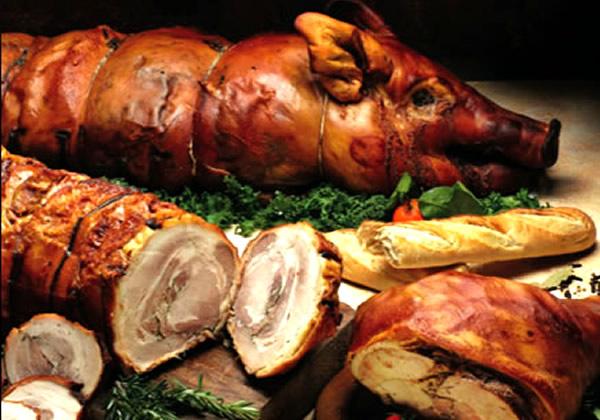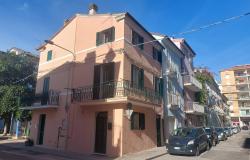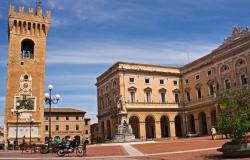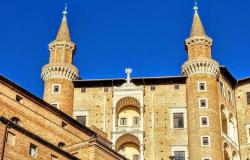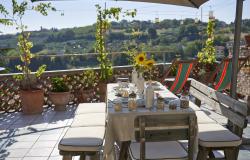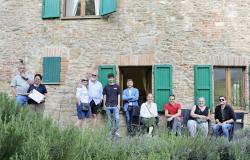Words by Chiara Paolin
Those who visit Le Marche find themselves faced with a deep quandary: is it better for sight-seeing or for eating and drinking? Let us start from the fact that it is the only region of Italy whose name is plural (the Marches): this plurality is clearly seen in the vast diversity of landscapes, from the mountains to the sea, from the countryside to its ancient cities. Located in the centre of the Italian peninsula, it has its roots in the ancient land of Piceno (9th-4th centuries BC) and still boasts a vast range of dialects and folklore traditions.
These are evident in the region’s cuisine. In the north, dishes are very similar to those of neighbouring Romagna, with pasta dishes such as cappelletti, passatelli and tagliatelle, while in the south the influence comes from Abruzzo, Lazio and Umbria.
 However, there are two key features of the regional cuisine which are strongly linked to the region’s main geographical areas, the hinterland and the coast. In farming communities, dishes are deeply rooted in the land: a multitude of fresh egg pastas, such as ravioli, cannelloni and cappellacci; meat from animals which are allowed to range free (beef from Marchigiana cattle is appreciated all over the country, and other animals such as pigs, rabbits, chickens and capons are highly prized).
However, there are two key features of the regional cuisine which are strongly linked to the region’s main geographical areas, the hinterland and the coast. In farming communities, dishes are deeply rooted in the land: a multitude of fresh egg pastas, such as ravioli, cannelloni and cappellacci; meat from animals which are allowed to range free (beef from Marchigiana cattle is appreciated all over the country, and other animals such as pigs, rabbits, chickens and capons are highly prized).
The land also provides rich harvests of vegetables and funghi, including the renowned truffle, the world’s most flavoursome tuber, sublime when shaved over a dish of home-made tagliolini. It is an important resource for the rural economy, sold through the markets at Acqualagna and Sant’Angelo in Vado, which account for one-third of all the country’s production.
Victorious victuals
 As everyone knows, the problem with the truffle is its astronomical price, so in the home the traditional dish for important occasions is vincisgrassi – lasagne with alternating layers of sauces made from chicken, beef and mushrooms. First described as ‘pringsgras’ by Antonio Nebbia in ‘Il Cuoco Maceratese’ (1783), the name derives from Prince Windisch-Graetz, who made the dish famous in 1799 when he led the Austrian army which released Ancona from Napoleonic rule, and ate vincisgrassi at his celebratory feast.
As everyone knows, the problem with the truffle is its astronomical price, so in the home the traditional dish for important occasions is vincisgrassi – lasagne with alternating layers of sauces made from chicken, beef and mushrooms. First described as ‘pringsgras’ by Antonio Nebbia in ‘Il Cuoco Maceratese’ (1783), the name derives from Prince Windisch-Graetz, who made the dish famous in 1799 when he led the Austrian army which released Ancona from Napoleonic rule, and ate vincisgrassi at his celebratory feast.
 Another speciality of marchigiana cuisine is found in stuffed delicacies, such as the calcioni of Treia, large sweet and savoury ravioli filled with ricotta cheese and lemon. But perhaps the most characteristic stuffed delicacies are olive all’ascolana. These are made from the delicious green olives grown only around Ascoli Piceno, stuffed with roast meat, egg and parmesan cheese, coated in breadcrumbs and deep-fried. But beware: it is all too easy to become addicted to this wonderful dish.
Another speciality of marchigiana cuisine is found in stuffed delicacies, such as the calcioni of Treia, large sweet and savoury ravioli filled with ricotta cheese and lemon. But perhaps the most characteristic stuffed delicacies are olive all’ascolana. These are made from the delicious green olives grown only around Ascoli Piceno, stuffed with roast meat, egg and parmesan cheese, coated in breadcrumbs and deep-fried. But beware: it is all too easy to become addicted to this wonderful dish.
Turning now to the coast, as you would expect, here you will find a wide variety of dishes based on fish and other seafood. Brodetto di pesce, a fish soup, is found everywhere, but differs from port to port. Around Pesaro it is red (made with tomatoes) and in Ascoli yellow (with saffron). In Ancona, be sure to try the wonderful stoccafisso, made from fish, potatoes, olives, tomatoes and extra virgin olive oil, a delicacy which Garibaldi insisted on during his exile on St. Helena, snubbing the fish from the Tyrrhenian Sea.
Goody bag
 If you are in Ancona, be sure to visit La Bontà delle Marche (Corso Mazzini 96/98, 60121
If you are in Ancona, be sure to visit La Bontà delle Marche (Corso Mazzini 96/98, 60121
Ancona - Tel. (+39) 071 53985.), a typical bottega which promotes the region’s best produce. Right in the heart of the city, facing the Baroque fountain with 13 spouts, built over a structure dating back to Roman times, the bottega also has a restaurant, where you can sample the stoccafisso described above, and try out many other delicacies before you decide which to stuff in your suitcase.
One product you are sure to buy is Le Marche’s wonderful extra virgin olive oil. It owes its excellent quality to several factors: the variety of olive used, the unique combination of soil and climate, the expertise of the oil pressers, whether in ultra-modern establishments or small mills which still extract the oil using millstones. The result is an oil which for years has received international recognition. It is an excellent foodstuff, medium-light and fruity, with overtones of herbs, flowers and almonds: just sprinkle some on a slice of bread and you will understand why it is so highly prized.
Wines for all
 Tasting food, of course, is nothing unless accompanied by good wine, and here again Le Marche does not disappoint. The hills, gently sloping from the Apennines to the sea, combined with a climate perfect for viniculture, produce delicately perfumed grapes rich in sugar.
Tasting food, of course, is nothing unless accompanied by good wine, and here again Le Marche does not disappoint. The hills, gently sloping from the Apennines to the sea, combined with a climate perfect for viniculture, produce delicately perfumed grapes rich in sugar.
- The most famous Le Marche wine is the white Verdicchio dei Castelli di Jesi. Straw-yellow, with subtle overtones of nuts, honey and flowers, it has a full-bodied dry flavour with a pleasant, slightly bitter after-taste. Many experts consider it the best Italian wine to accompany fish.
 - The Monte Conero area around Ancona is the home of Rosso Conero, a wine with an ancient tradition, made from the Montepulciano grape. Morro d’Alba produces Lacrima, a red wine enjoyed by Barbarossa.
- The Monte Conero area around Ancona is the home of Rosso Conero, a wine with an ancient tradition, made from the Montepulciano grape. Morro d’Alba produces Lacrima, a red wine enjoyed by Barbarossa.
- The Metauro valley is the place to find Bianchello, a delicious white wine, while the south of the region is dominated by Rosso Piceno, ruby-red in colour, its lingering flavour overlaid with hints of wild berry fruits. The list continues, with Vernaccia di Serrapetrona, a sweet or semi-sweet sparkling wine and Falerio dei Colli Ascolani, a fresh, dry white. And don’t miss the sublime Verdicchio di Matelica! Round off your meal with a fortified wine or an aniseed-based liqueur.
 Feeling a bit tipsy? No problem! Just nibble on a slice of cheese, such as the sweet caciotta d’Urbino with blackberry compote, or the stronger pecorino di fossa, matured in caves deep in the tufa rock and flavoured with walnut leaves, truffle or grape must.
Feeling a bit tipsy? No problem! Just nibble on a slice of cheese, such as the sweet caciotta d’Urbino with blackberry compote, or the stronger pecorino di fossa, matured in caves deep in the tufa rock and flavoured with walnut leaves, truffle or grape must.
If the cheese doesn’t do the trick, try a few slices of the local cured meats:
- porchetta flavoured with juniper and fennel,
- the soft, spreadable ciauscolo;
- wonderful prosciutto di Carpegna;
- the delicate salame di Fabriano.
If, by now, your mouth is watering at the thought of these marchigiani delicacies, it’s time to pay the region a visit or, failing that, contact the website below and have Le Marche delivered to your door!
